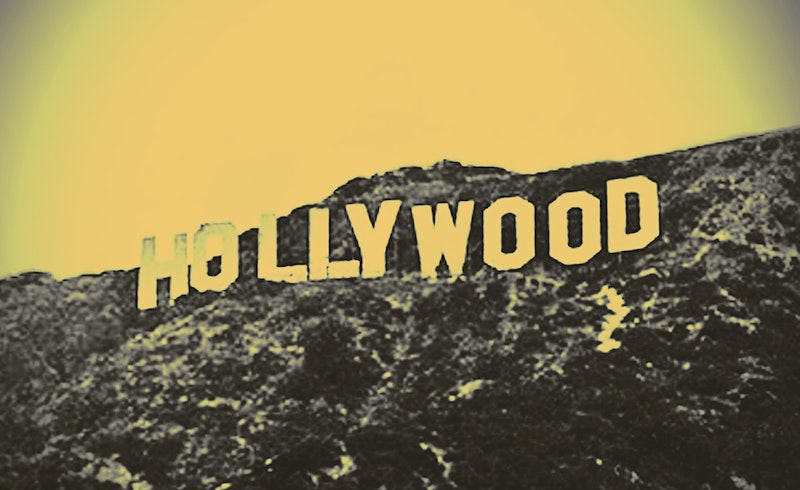Hollywood perfected the American Western. The drugstore cowboys who congregated at Gower Gulch in search of extra work from Central Casting were the real deal. Downtown Hollywood, a neighborhood in Los Angeles, is a cinema epicenter with its golden celebrity stars embedded in the Walk of Fame sidewalks. The location speaks to the fascinating, affluent and powerful motion picture industry. A onetime, productive agricultural region fostered the growth of the dream factories; a thriving mix of television, music and film production that saw creative visions come to life. This is where Dorothy said, “Toto, I’ve a feeling we’re not in Kansas anymore.”
Unfortunately, the world’s showbiz capital is in crisis. How many times have you noticed the same scenes in today’s films? For instance, an endless opening drone sequence of a car swerving along a deserted road in a dark forest, or the power squad shot of several heroes walking in a row towards the camera in slow motion, ready to kick some ass? Redundancy is the least of Hollywood’s worries.
It’s easy to whine, but there’s a number of serious problems and reasons for concern. Recall how the switch from film to digital was a groundbreaking moment; gone was the vinegary odor of film stock being processed, noticeable on a drive down Melrose Ave. Compared to today’s catastrophic earthquake, that’s a minor aftershock: Movie production grinded to halt by Covid, followed by a labor strike, the California wildfires, the explosive growth of streaming services, the influence of social media to make or break films, problems with AI content, and a labor shortage that resulted in layoffs. Aftereffects are still felt by filmmakers, actors, and audiences alike.
The current post-pandemic world has left studios nervous, hesitant to invest large sums in big name films, hence fewer productions. There’s been a significant drop-off in box-office receipts, except for a handful of feature hits. The screening window for theatrical releases has shrunk. Movie theaters have closed. Productions moved out of Los Angeles to other locations. Content migrated over to Amazon, Apple TV, Netflix and other home streaming services offering different benefits and viewership options. Young people are enjoying staying at home past adulthood playing video games and binge-watching. This is no surprise—the “control” generation wants material available for consumption immediately across all media formats.
Filmmakers agree the business has changed. Director Todd Haynes expressed dismay in Variety, “We’re in a state of particular crisis right now in the United States, but also globally.” Quentin Tarantino knows; from his recent The Video Archives Podcast series, “The current era of Hollywood is the worst ever… it’s a show pony exercise.”
Recalling some personal Hollywood trivia: On the site where scenes from D. W. Griffith’s film Intolerance was filmed before the theater was built, Byron Baker lived in an apartment space inside the historic Vista Theater during the mid-1980s. In 2021, Tarantino bought the ex-gay porn palace for a restoration that now includes 70mm projection. I had goosebumps the size of the Santa Monica Mountains standing on a balcony behind the classic neon marquee, where you look down on the intersection of Hillcrest Ave., Hollywood Blvd. and Sunset Drive, which was also an album cover location for the band Suicidal Tendencies. I thought to myself given the historical significance, this is the town where young Peg Entwistle jumped off the sign and ended her life.
Another problem, unless you’re doing your film school homework, there’s such a vast amount of content available, people are confused. Who has what? What app do you need? Less enthusiastic are your index fingers getting tired from a nightly work-out on your home clicker searching for entertainment. If you do like seeing movies at theaters or art houses, good luck. In certain situations, does anyone really appreciate a lax noise policy for the small ones while sitting in a giant La-Z-Boy, as the jerk sitting next to you wolfs down a pizza, drinks a beer, and then lets out a loud belch? It’s amazing how far disturbing public behavior will go.
Any new ideas? One might assume there’s plenty of fresh stories available when authors sell their book rights for options. An agent is generally needed to get payment. Meanwhile, your book’s held hostage by the studios, while you wait for a green light. Less than one percent of these projects get made.
Keeping abreast of patterns, it remains to be seen if adventurous and unorthodox filmmakers will have the stamina for the filmmaking process. Independents know swimming against the mainstream current is difficult, but the risks can also be rewarding. Recognizing the rising tide in global financial problems and ongoing political extremes are also factors. There’s plenty here to swallow and digest.
To audiences’ delight, there are a few bright spots. Brothers Jay and Mark Duplass have produced a variety of independent projects including an upcoming comedy The Baltimorons shot in Baltimore. I wonder if capturing the edges of society will still interest award-winning Sean Baker with his love of the silver screen? And what about director, actor, writer Mike White? His diverse resume path includes some great early features, Chuck & Buck and The Good Girl. A recent New Yorker profile gave insight on why he decided to do The White Lotus.
The plot thickens as Hollywood continues to flex its muscles and shifts focus searching for new ways to make entertainment. What happens next is a mystery. I hope it won’t be a Neuralink brain chip implant that automatically updates itself controlling all human functions. Contact them for advertising rates. The show must go on.

